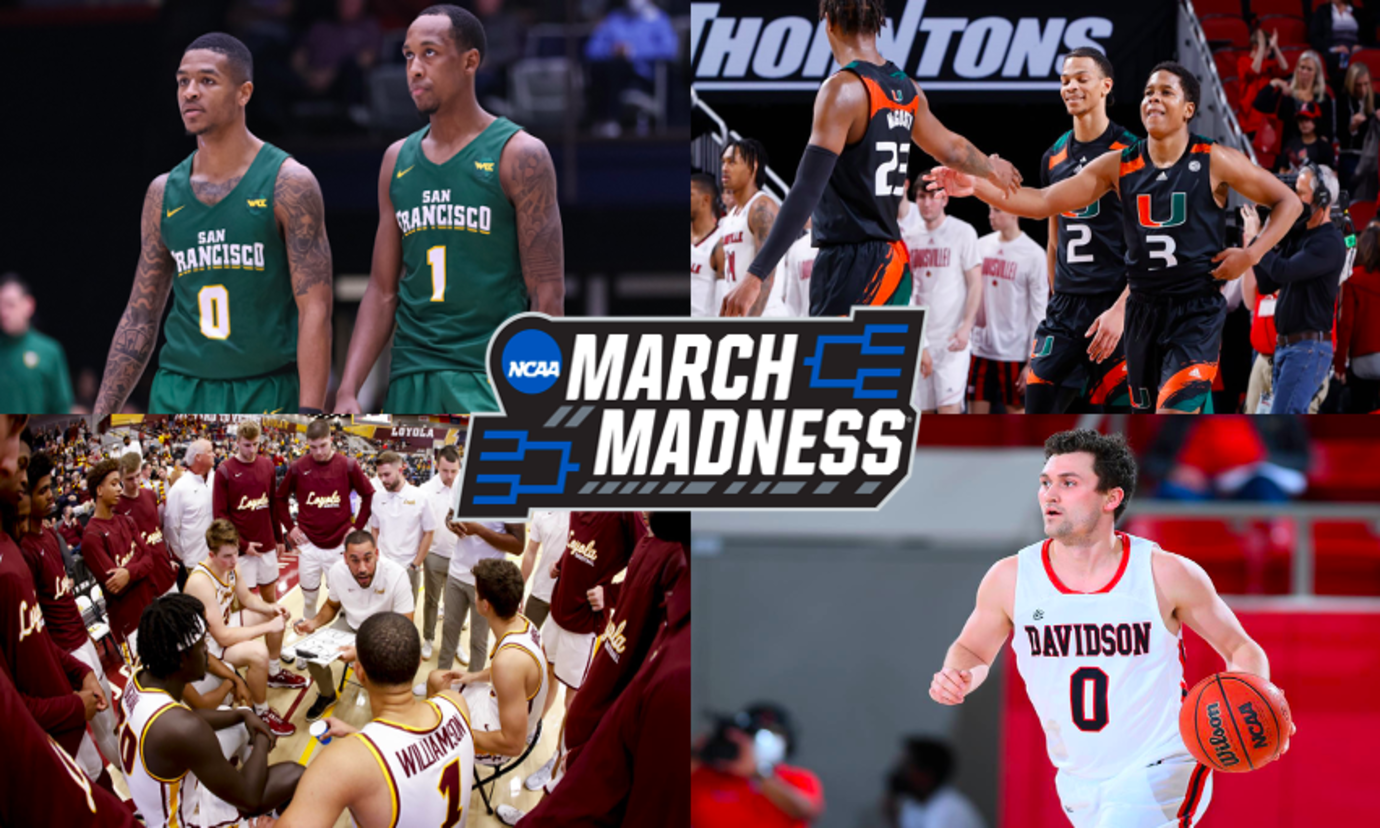The History of the 10-7 Matchup and 2022 Preview
In the first round of March Madness, #7 seeds have fared pretty well against the #10 seeds they meet in the first round. The #7 seeds currently enter the 2022 March Madness Tournament with an 87-57 record (60.4%-win rate) against their double-digit-seeded counterparts. Since 2010, eighteen #10 seeds have pulled off the minor-upset, including the 10s winning 3 of 4 matchups in both 2019 and 2010. This year, the #10 seeds look poised to inch back closer to .500 and could replicate those two first-round results from 3 and 12 years ago. On top of this, it is very viable that this group of #10 seeds could sweep the #7 seeds. For March Madness in 2022, the #10 line consists of San Francisco, Davidson, Loyola Chicago, and Miami (FL).

Experience and Great Guard-Play Make the #10 Seeds Scary
All four of these programs enter the tournament with two very promising attributes that are generally needed to make an upset happen; tons of experience and high-level guard play. Two of the four #10 seeds even enter the tournament as favorites according to Las Vegas and none of the #10 seeds are bigger than a 1.5-point underdog:
- #10 San Francisco is currently favored by 1.5 points over #7 Murray State
- #10 Davidson is currently favored by 1 point over #7 Michigan State
- #10 Loyola Chicago is currently only a 0.5-point underdog against #7 Ohio State
- #10 Miami is currently only a 1.5-point underdog against #7 USC
San Francisco Dons

According to advanced stats like KenPom and NET, the Dons from San Francisco were one of the most disrespected teams on Selection Sunday when it came to seeding. Ranked 21st in KenPom and 22nd in NET Ranking, the advanced stats indicate San Francisco could have been as high as a #6 seed in March. While they did have the bad luck of drawing a Murray State team who is 30-2 this season, the Dons will still have the best player on the court in this game in Jamaree Bouyea.
Jamaree Bouyea is a projected late-first/early-second round pick in the upcoming NBA draft and he leads the Dons in PPG (16.7), APG (4.0), SPG (1.8) and MPG (35.9). In the starting lineup, he is joined by five seniors. I repeat… FIVE SENIORS. Most notably, Khalil Shabazz gives Bouyea a great back-court mate and Yauhen Massalski dominates the paint down low for the Dons. Murray State has had a historic season, but San Francisco could be handing them their third and final loss of the season in the first round.
Loyola Chicago Ramblers

The team that almost mirrors San Francisco and another mid-major team that was seemingly underrated on Selection Sunday were the Ramblers of Loyola Chicago. Much like San Francisco, the Ramblers’ advanced stats are spectacular. They rank 24th in KenPom and 23rd in NET Ranking, indicating that they too, could have been seeded as high as a #6 seed. They enter March Madness with tons of momentum as well, coming off of their MVC Tournament Championship. Ohio State, on the other hand, enter the Madness losing 3 of their last 5 games.
Sticking with the positive theme of experience and elite guard play, Loyola Chicago’s top 7 players in terms of minutes played consist of five seniors and two juniors. Lucas Williamson and Braden Norris are both solid scorers (14.0 and 10.3 PPG) who also average 3.0 and 3.9 assists per game. The two of them are the leading scorers and assist-men on the roster.
While Ohio State carries 9 seniors on their roster, when you get down to the players who will actually be on the court for crunch time, you start to see more and more inexperience. Ohio State’s 2nd and 4th leading scorers this season are Malaki Branham, a freshman who has never seen the intensity of March Madness, and Zed Key, a sophomore who has shown inconsistencies and recently seen his rotation minutes dwindle. If the Ramblers can limit EJ Liddell on offense, Ohio State might not have an answer for Sister Jean’s lucky Loyola team.
Davidson Wildcats

Davidson is the first team in this #10 group that was not underrated on Selection Sunday, likely due to them losing in their conference championship game to Richmond. Regardless, that should not make you any less interested in them as an upset pick. Davidson is one of the most elite offensive teams in the nation and rank 11th in adjusted offensive efficiency. Every team ranked above Davidson in this category are #5 seeds or better in March Madness. Their opponent, Michigan State, rank 38th in this metric… But MSU has an elite defense right? Wrong. Despite the perception, Michigan State actually ranks 55th in adjusted defensive efficiency, meaning that while most teams in March Madness excel on at least one side of the floor, MSU does not.
The other main reason Davidson is so likeable in this matchup is that Michigan State’s backcourt is very young. Their 4 guards who play the vast majority of the backcourt minutes consist of two freshmen (Max Christie and Jaden Akins), one sophomore (A.J. Hoggard), and one junior (Tyson Walker). Meanwhile, Davidson’s guard minutes are led by three upper-classmen. Foster Loyer, Michael Jones, and Hyunjung Lee combine for 93.2 minutes played per game and are all juniors (with Loyer being a 4th-year junior). On top of this, as many college basketball fans already know, this is a revenge game for Foster Loyer, who spent his previous three seasons playing for Tom Izzo and the Spartans. Look for him to impose his will on the inexperienced MSU guards and lead Davidson in a nail-biter.
Miami (FL) Hurricanes

Now we get to the biggest underdog of these 10-7 matchups in Miami (FL). In a battle of the giant USC team and the small-ball Hurricanes team, it is much harder to predict how the game will go. Miami starts Charlie Moore (5’11”), Isaiah Wong (6’2”) and Kameron McGusty (6’5”), making them one of the smallest backcourts in the tournament. With that being said, the Canes starting lineup consists of players who have 21 total seasons under their belts and Miami’s small-ball style is highly effective. The Hurricanes rank 17th in adjusted offensive efficiency.
Moving onto USC, the Trojans rank 48th in this metric. They also rank 49th in adjusted defensive efficiency, presenting the same problem as Michigan State in that they are not elite on either side of the floor. The Trojans do have a balanced scoring attack with Isaiah Mobley, Boogie Ellis, Drew Peterson, and Chevez Godwin, but this game could be the epitome of a grind-it-out match. With Miami and USC ranking 242nd and 192nd respectfully in possessions per game, the pace will be slooooow. Taking the Canes team that is much more efficient on offense and is more likely to score in the half-court makes the most sense. Notably, this game is definitely the hardest matchup for our #10 seeds, but when there’s a will, there’s a way.




